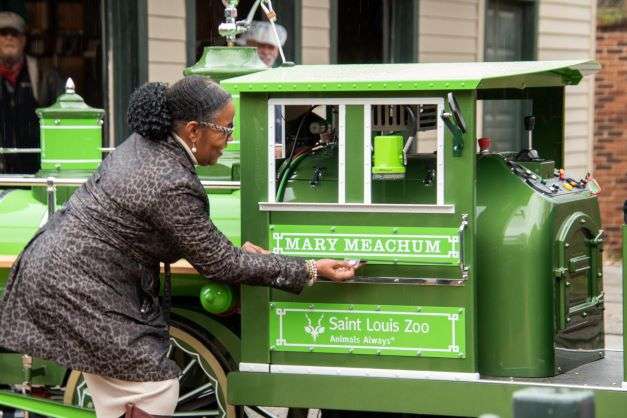The Saint Louis Zoo Emerson Zooline Railroad has added a new train with a green initiative. This additional locomotive is an electric train, which accompanies the six other locomotives that are currently in use at the Zoo. The electric train made its first public debut today Tuesday March 28, 2023, with a short ceremony revealing the name of the newest train.
Train named after Mary Meachum
The electric train is named after Mary Meachum, an abolitionist in St. Louis who was instrumental in educating Black people and played a critical role in the Underground Railroad. This is the Zoo’s first train named after a woman.
“March is Women’s History Month, and we couldn’t imagine a more fitting time to announce Mary Meachum as the name of the newest train,” said Michael Macek, director, Saint Louis Zoo.
Mary and her husband, John Berry Meachum, established a school for free and enslaved Black children called “a candle tallow school” in the basement of the church. Once Missouri law banned Black people from being educated in 1847, the Meachums moved the school to the Mississippi River aboard a steamboat where Missouri law could not be enforced. The “Floating Freedom School” helped better the lives of enslaved people by educating those that needed it the most. Mary also used her home as a safe house on the Underground Railroad and helped move enslaved people to freedom—across the Mississippi River from the St. Louis area to Illinois.
“Escaping, running away was the ultimate form of resistance to enslavement and there were many who helped in escapes, but there were many runaways who made it on their own,” said Angela da Silva, retired university professor and cultural preservationist. “The law was clear. Anyone caught aiding and abetting a runaway risked monetary fines, public lashings and imprisonment. Mary Meachum took that risk on May 21, 1855. As a free born woman of color, she added that risk of being enslaved herself, yet she did what she could to aid her enslaved brethren.”
Electric train
The new electric train brings a positive, long-term environmental impact on the Zoo with less gas emission and using more sustainable resources. “As the trains at the Zoo begin to age, replacing the locomotives with a much greener approach will set us up for a better future,” said Macek. “We are excited as we look ahead to the future of the Emerson Zooline Railroad and will continue to help create memories that will last a lifetime.”
The electric train has a green locomotive at the front of the train, along with new coach carriers behind it. The style and color are the same as the other train coaches. The new locomotive includes a new but recognizable train whistle and the number 50 on its side. The electric train was created and developed by Chance Rides located in Wichita, Kansas.
Emerson Zooline Railroad
The Zooline Railroad is celebrating its 60th anniversary this year. Construction began on the train in 1962. The railroad opened on August 30, 1963, costing approximately $300,000. When it first opened, the train cost 30 cents to ride. In 2010, the railroad was renamed the Emerson Zooline Railroad when the Zoo received a generous $5 million gift from Emerson. Since then, it has been the number one non-animal attraction at the Zoo.
The Zooline Railroad has 1.5 miles of track around the Zoo and can travel up to 8 miles an hour. With 10 train dispatchers, 50 engineers and holding nearly 80 guests on the train, the Zooline Railroad has served over 41 million people since its opening in 1963.
The Zooline Railroad’s engines are replicas of the original C. P. Huntington, a famous steam locomotive first built in 1863, at about one-third the size. Each of the trains at the Zoo is named after an important figure in St. Louis history. The train began with the “The Spirit of St. Louis” locomotive; the family later grew to include the #45, Daniel Boone (1991); #46, Pierre Laclede (1993); #47, Lewis & Clark (1995); #48, Ulysses S. Grant (1998); #49, Charlton Tandy (1999); and #100, Emerson (2010).






